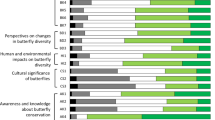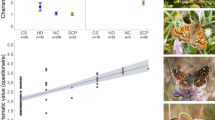Abstract
Invertebrates have a low public profile and are seriously underrepresented in global conservation efforts. The promotion of flagship species is one way to generate interest in invertebrate conservation. Butterflies are frequently labeled invertebrate flagships, but clear definitions of the conservation actions they are meant to catalyze, and empirical assessments of their popularity amongst non-Western audiences are lacking. To improve the use of invertebrate flagships, we examine how butterflies compare with other taxa in terms of popularity. We then identify characteristics of individual species that are appealing and explore whether these may be used to derive a set of guidelines for selecting invertebrate flagships. We conducted questionnaire-based surveys amongst two target audiences: rural residents (n = 255) and tourists (n = 105) in northeast India. Invertebrates that were aesthetically appealing, or those that provided material benefits or ecological services were liked. Butterflies were the most popular group for both audiences, followed by dragonflies, honeybees and earthworms. A combination of large size and bright colours led to high popularity of individual species, whilst butterflies with unique features were liked by tourists but not rural residents. These results provide empirical evidence that butterflies appeal to diverse audiences and have the potential to be deployed as flagships in different contexts. However, prior to promoting invertebrate flagships, their intended uses need to be specified. Here we define an invertebrate flagship as an invertebrate species or group that resonates with a target audience and stimulates awareness, funding, research and policy support for the conservation of invertebrate diversity. In conclusion we outline a set of heuristic guidelines for selecting flagships to raise awareness of invertebrate diversity and conservation.



Similar content being viewed by others
Notes
We are grateful to Diogo Veríssimo for this observation.
References
Barua M (2011) Mobilizing metaphors: the popular use of keystone, flagship and umbrella species concepts. Biodivers Conserv 20:1427–1440
Barua M, Tamuly J, Ahmed RA (2010) Mutiny or clear sailing? Examining the role of the Asian elephant as a flagship species. Human Dimens Wildl 15(2):145–160
Barua M, Root-Bernstein M, Ladle RJ, Jepson P (2011) Defining flagship uses is critical for flagship selection: a critique of the IUCN climate change flagship fleet. Ambio 40(4):431–435. doi:10.1007/s13280-010-0116-2
Berenbaum M (2008) Insect conservation and the entomological society of America. Am Entomol 54(2):117–120
Bowen-Jones E, Entwistle A (2002) Identifying appropriate flagship species: the importance of culture and local contexts. Oryx 36(2):189–195
Browne-Nuñez C, Jonker SA (2008) Attitudes toward wildlife and conservation across Africa: a review of survey research. Human Dimens Wildl 13:47–70
Cardoso P, Erwin TL, Borges PAV, New TR (2011) The seven impediments in invertebrate conservation and how to overcome them. Biol Conserv 144:2647–2655
Caro TM (2010) Conservation by Proxy. Island Press, Washington DC
Clark JA, May RM (2002) Taxonomic bias in conservation research. Science 297(5579):191–192
Clucas B, McHugh K, Caro T (2008) Flagship species on covers of US conservation and nature magazines. Biodivers Conserv 17:1517–1528
Costa-Neto EM, Magalhães HF (2007) The ethnocategory “insect” in the conception of the inhabitants of Tapera County, São Gonçalo dos Campos, Bahia, Brazil. Ann Brazil Acad Sci 79(2):239–249
Davey GCL, McDonald AS, Hirisave U, Prabhu GG, Iwawaki S, Jim CI, Merckelbach H, de Jong PJ, Leung PWL, Reimann BC (1998) A cross-cultural study of animal fears. Behav Res Ther 36(7–8):735–750
De Leon JP, Cohen JH (2005) Object and walking probes in ethnographic interviewing. Field Methods 17(2):200–204
DeFoliart GR (1999) Insects as food: why the western attitude is important. Annu Rev Entomol 44:21–50
Evans WH (1932) The identification of Indian butterflies, Revised 2nd edn. Bombay Natural History Society, Mumbai
Guiney MS, Oberhauser KS (2008) Insects as flagship conservation species. Terr Arthropod Rev 1:111–123
Heywood VH (1995) Global biodiversity assessment. Cambridge University Press, Cambridge
Home R, Keller C, Nagel P, Bauer N, Hunziker M (2009) Selection criteria for flagship species by conservation organizations, vol 36. Cambridge Journals Online. First published. doi:10.1017/S0376892909990051
Jin X-B, Yen AL (1998) Conservation and the cricket culture in China. J Insect Conserv 2:211–216
Joshi RC, Matchoc ORO, Bahatan RG, Dela Peña FA (2000) Farmer’s knowledge, attitudes and practices of rice crop and pest management at Ifugao Rice Terraces, Philippines. Int J Pest Manag 46(1):43–48
Kellert SR (1993) Values and perceptions of invertebrates. Conserv Biol 7(4):845–855
King MF, Bruner GC (2000) Social desirability bias: a neglected aspect of validity testing. Psychol Mark 17(2):79–103
Lemelin RH (2007) Finding beauty in the dragon: the role of dragonflies in recreation and tourism. J Ecotour 6(2):139–145
Lewis OT, Basset Y (2007) Insect conservation in tropical forests. In: Stewart AJA, New TR, Lewis OT (eds) Insect conservation biology. The Royal Entomological Society and CABI, Wallingford, pp 34–56
Lewis O, Senior M (2011) Assessing conservation status and trends for the world’s butterflies: the Sampled Red List Index approach. J Insect Conserv 15(1):121–128
Lorimer J (2007) Non-human charisma. Environ Plan D Soc Space 25(5):911–932
New TR (1997) Are Lepidoptera an effective ‘umbrella group’ for biodiversity conservation? J Insect Conserv 1:5–12
New TR (1999) Untangling the web: spiders and the challenges of invertebrate conservation. J Insect Conserv 3:251–256
New TR (2009) Insect species conservation. Cambridge University Press, Cambridge
New TR (2011) Launching and steering flagship Lepidoptera for conservation benefit. J Threat Taxa 3(6):1805–1817
New TR, Pyle RM, Thomas JA, Thomas CD, Hammond PC (1995) Butterfly conservation management. Annu Rev Entomol 40:57–83
Parsons MJ (1992) The world’s largest butterfly endangered; the ecology, status and conservation of Ornithoptera alexandrae (Lepidoptera: Papilionidae). Trop Lepidoptera 3(1):33–60
Pe’er G, Settele J (2008) Butterflies in and for conservation: trends and prospects. Israel J Ecol Evol 54(1):7–17
Ryan GW, Bernard HR (2003) Techniques to identify themes. Field Methods 15(1):85–109
Samways MJ (1994) Insect conservation biology. Chapman & Hall, London (First published)
Samways MJ (2007a) Insect conservation: a synthetic management approach. Annu Rev Entomol 25:465–487
Samways MJ (2007b) Rescuing the extinction of experience. Biodivers Conserv 16:1995–1997
Sands DPA, Scott SE, Moffat R (1997) The threatened Richmond birdwing butterfly (Ornithoptera richmondia (Gray)): a community conservation project. Mem Mus Vic 56:449–453
Schlegel J, Rupf R (2010) Attitudes towards potential animal flagship species in nature conservation: a survey among students of different educational institutions. J Nat Conserv 18:278–290
Steencamp C, Stein R (1999) The Brenton Blue Saga. A case study of South African biodiversity conservation. Endangered Wildlife Trust, Parkview
Van Hook T (1997) Insect coloration and implications for conservation. Fla Entomol 80(2):193–210
Veríssimo D, Fraser I, Groombridge J, Bristol R, MacMillan DC (2009) Birds as tourism flagship species: a case study of tropical islands. Anim Conserv 12:549–558. doi:10.1111/j.1469-1795.2009.00292.x
Veríssimo D, MacMillan DC, Smith RJ (2011) Toward a systematic approach for identifying conservation flagships. Conserv Lett 4:1–8
Veríssimo D, Barua M, Jepson P, MacMillan DC, Smith RJ (2012) Selecting marine invertebrate flagship species: widening the net. Biol Conserv 145(1):4
Warren MS, Bourn N, Brereton T, Fox R, Middlebrook I, Parsons MS (2007) Insect conservation in tropical forests. In: Stewart AJA, New TR, Lewis OT (eds) Insect conservation biology. The Royal Entomological Society and CABI, Wallingford, pp 76–91
Wilson EO (1987) The little things that run the world. Conserv Biol 1:344–346
Wilson EO (1992) The diversity of life. Harvard University Press, Cambridge
Acknowledgments
We extend our gratitude to the Flagship Species Fund Small Grants Programme of Flora and Fauna International and the Sigma Xi Grants-in-Aid of Research (GIAR) program which provided funding for this project. We would like to thank all members of Butterfly Northeast who were instrumental in project preparation, planning, and implementation, including: Bipul Das, Santanu Dey, Sanjay Talukdar, and Rajib Rudra Tariang. Meredith Root-Bernstein and Dr Owen Lewis commented on earlier drafts of this paper. Nekib Ali, Polash Bora, Phalgun Chetia, Diganta Gogoi, Tarun Gogoi, Biju Hazarika, and Pradip Saikia extended invaluable assistance during fieldwork, and the staff and management of Wild Grass, Kaziranga hosted our team. MB’s work was enabled by the University of Oxford Clarendon Fund, Felix and Wingate Scholarships. Finally, we are grateful to all the individuals who took the time to speak with us and answer our questionnaires.
Author information
Authors and Affiliations
Corresponding author
Electronic supplementary material
Below is the link to the electronic supplementary material.
Rights and permissions
About this article
Cite this article
Barua, M., Gurdak, D.J., Ahmed, R.A. et al. Selecting flagships for invertebrate conservation. Biodivers Conserv 21, 1457–1476 (2012). https://doi.org/10.1007/s10531-012-0257-7
Received:
Accepted:
Published:
Issue Date:
DOI: https://doi.org/10.1007/s10531-012-0257-7




